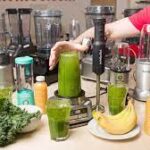A kettle is an essential appliance in any kitchen, whether you’re an avid tea drinker, a coffee enthusiast, or just need hot water quickly. But with so many options available, how do you choose the perfect kettle? In this guide, we’ll walk you through everything you need to know to make an informed decision.
Types of Kettles
- Electric Kettles: Fast and efficient, electric kettles are perfect for those who need boiling water in a hurry. They come in various styles and capacities, often with additional features like temperature control and keep-warm functions.
- Stovetop Kettles: Traditional and stylish, stovetop kettles are a great addition to any kitchen. They’re perfect for those who enjoy the ritual of boiling water and appreciate a classic design.
Key Features to Consider
- Capacity: Consider how much water you typically need to boil. Kettles range from small, personal sizes to larger models that can handle multiple cups at once.
- Material: Kettles come in various materials including stainless steel, glass, and plastic. Stainless steel is durable and retains heat well, while glass allows you to see the water level and adds a modern touch. Plastic is lightweight and often more affordable.
- Boiling Speed: If you’re often in a hurry, look for a kettle with a high wattage, which will boil water faster.
- Temperature Control: For tea aficionados, temperature control is a crucial feature. Different types of tea require different brewing temperatures, so this feature can make a big difference in flavor.
- Safety Features: Auto shut-off and boil-dry protection are essential for safety, ensuring the kettle turns off automatically when the water reaches boiling point or if there’s no water inside.
Popular Brands and Models
- Breville: Known for their high-quality appliances, Breville offers kettles with precise temperature control and stylish designs.
- Cuisinart: A household name, Cuisinart kettles are reliable and often come with useful features like keep-warm functions and preset temperature settings.
- Hamilton Beach: This brand provides affordable and functional kettles that are perfect for everyday use.
Maintenance Tips
To keep your kettle in top condition, regular maintenance is key. Descale your kettle every few months to remove mineral buildup, especially if you have hard water. Simply fill the kettle with a mixture of vinegar and water, let it sit for an hour, then rinse thoroughly.
Choosing the right kettle can enhance your daily routine, making it easier and more enjoyable to prepare your favorite hot beverages. Consider your specific needs and preferences, and you’ll find the perfect kettle that fits seamlessly into your kitchen and lifestyle.


The Fascinating History of the Kettle
The kettle is a household staple with a rich history that spans centuries and continents. From its early origins to the modern electric versions we use today, the kettle has evolved significantly. Let’s take a journey through time and explore the history of the kettle.
Early Origins
The earliest kettles date back to ancient Mesopotamia around 3500 BC. These primitive vessels were made of bronze and used for boiling water over open flames. Early kettles were functional but rudimentary, reflecting the technological capabilities of the time.
The Middle Ages
During the Middle Ages, the design of the kettle began to evolve. In Europe, particularly in the 9th century, kettles made of iron and other metals became more common. These were often used in conjunction with open hearths for cooking and boiling water. The design included a spout for pouring and a handle for easier use.
The Introduction of the Tea Kettle
The 17th century marked a significant shift with the introduction of the tea kettle, particularly in China and later in Europe. Tea drinking became a cultural practice, and the demand for specialized kettles grew. Chinese porcelain tea kettles were highly valued and often beautifully decorated, signifying status and sophistication.
The Industrial Revolution
The Industrial Revolution in the 18th and 19th centuries brought significant advancements in kettle production. Mass production techniques allowed for kettles to be made more efficiently and from a variety of materials, including copper and later stainless steel. This era also saw the advent of the whistling kettle, a design that alerted users when the water had boiled.
The Electric Kettle
The 20th century revolutionized kettle design with the invention of the electric kettle. The first electric kettle was developed in 1891 by the Carpenter Electric Company in the United States. However, it wasn’t until 1922 that the Swan Company introduced the first fully automatic electric kettle with a built-in thermostat.
Electric kettles quickly gained popularity due to their convenience and efficiency. Over the decades, improvements continued to be made, including the addition of features like automatic shut-off, variable temperature settings, and cordless designs.
Modern Innovations
Today, kettles come in a wide variety of styles and materials, from sleek stainless steel models to retro-inspired designs. The modern electric kettle can boil water in just a few minutes and often includes advanced features such as programmable temperature controls and keep-warm functions.
Cultural Significance
Throughout history, the kettle has not only been a practical tool but also a cultural symbol. In Britain, the kettle is central to the tradition of afternoon tea. In Japan, the ceremonial tea kettle, or “tetsubin,” plays a crucial role in the Japanese tea ceremony, emphasizing the importance of aesthetics and ritual.
The history of the kettle is a testament to human ingenuity and cultural exchange. From its humble beginnings in ancient Mesopotamia to the high-tech models of today, the kettle has remained a beloved and essential part of our daily lives. As technology continues to evolve, the kettle will undoubtedly continue to adapt, blending tradition with innovation.










